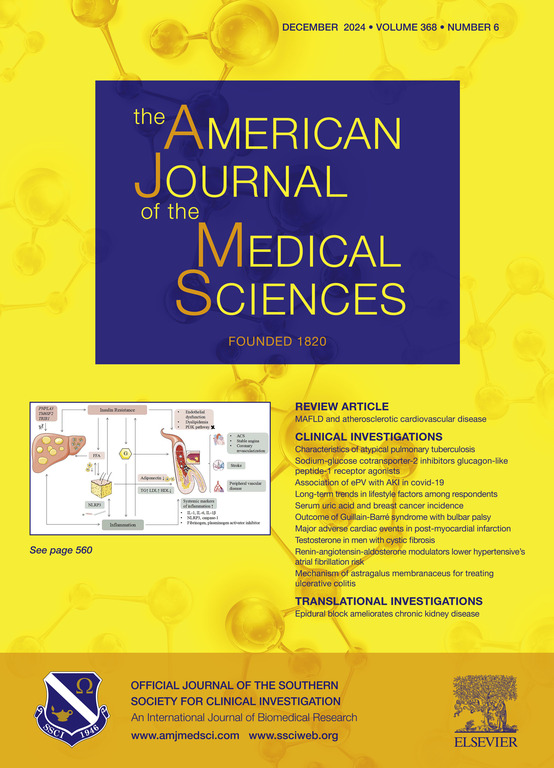Global longitudinal strain and the risk of major adverse cardiac events in post-myocardial infarction patients: A retrospective cohort study
IF 2.3
4区 医学
Q2 MEDICINE, GENERAL & INTERNAL
引用次数: 0
Abstract
Background
This study evaluates the relationship between global longitudinal strain (GLS) and late major adverse cardiovascular events (MACEs) in patients after acute myocardial infarction (AMI).
Methods
Data of newly diagnosed AMI patients between March 2010 and July 2014 were retrospectively evaluated. The patients underwent serial echocardiography at admission and at third and sixth months post-admission. We calculated GLS by averaging the strain from all myocardial segments using speckle-tracking echocardiography (STE). We used multivariate Cox regression analysis and receiver operating characteristic (ROC) curve analyses to assess the relationship between GLS at admission and late MACEs.
Results
Eighty-nine newly diagnosed AMI patients were enrolled. The average age at diagnosis was 61 ± 12.5 years, and approximately 89.9% of the patients were men. The average level of GLS was -17.5 ± 3.9%. The overall prevalence of MACEs was 23.6% (21/89), compared with 44% (11/25) in the group with GLS≥-15% and 17.9% (5/28) in the group with GLS<-20%. GLS was positively linked with MACEs in the fully adjusted Cox proportional hazard model (hazard ratio [HR], 1.19; 95% confidence interval [CI], 1.04–1.37; P=0.014) after adjusting potential confounders. The ROC curve analysis for one year MACEs between GLS at admission, with the most significant area under the curve(AUC) 78.1% (95% CI, 63.8% - 92.6%).
Conclusions
Myocardial dysfunction, characterized by impaired GLS, is often observed in AMI patients, and a decrease in GLS levels at admission were associated with an increased risk of long-term MACEs in post-myocardial infarction patients.
心肌梗死后患者的整体纵向应变与重大心脏不良事件的风险:一项回顾性队列研究
背景:本研究评估了急性心肌梗死(AMI)患者的整体纵向应变(GLS)与后期主要不良心血管事件(MACEs)之间的关系:本研究评估了急性心肌梗死(AMI)患者的整体纵向应变(GLS)与晚期主要不良心血管事件(MACE)之间的关系:方法: 对 2010 年 3 月至 2014 年 7 月间新确诊的急性心肌梗死患者的数据进行了回顾性评估。患者在入院时、入院后第三和第六个月接受了连续超声心动图检查。我们使用斑点追踪超声心动图(STE)计算所有心肌节段的应变平均值,从而计算出 GLS。我们使用多变量 Cox 回归分析和接收器操作特征曲线分析来评估入院时 GLS 与晚期 MACE 之间的关系:共纳入 89 名新诊断的 AMI 患者。诊断时的平均年龄为 61 ± 12.5 岁,约 89.9% 的患者为男性。GLS的平均水平为-17.5 ± 3.9%。MACE总发生率为23.6%(21/89),而GLS≥-15%组为44%(11/25),GLSC结论组为17.9%(5/28):心肌梗死患者常出现以 GLS 受损为特征的心肌功能障碍,入院时 GLS 水平下降与心肌梗死后患者长期 MACE 风险增加有关。
本文章由计算机程序翻译,如有差异,请以英文原文为准。
求助全文
约1分钟内获得全文
求助全文
来源期刊
CiteScore
4.40
自引率
0.00%
发文量
303
审稿时长
1.5 months
期刊介绍:
The American Journal of The Medical Sciences (AJMS), founded in 1820, is the 2nd oldest medical journal in the United States. The AJMS is the official journal of the Southern Society for Clinical Investigation (SSCI). The SSCI is dedicated to the advancement of medical research and the exchange of knowledge, information and ideas. Its members are committed to mentoring future generations of medical investigators and promoting careers in academic medicine. The AJMS publishes, on a monthly basis, peer-reviewed articles in the field of internal medicine and its subspecialties, which include:
Original clinical and basic science investigations
Review articles
Online Images in the Medical Sciences
Special Features Include:
Patient-Centered Focused Reviews
History of Medicine
The Science of Medical Education.

 求助内容:
求助内容: 应助结果提醒方式:
应助结果提醒方式:


